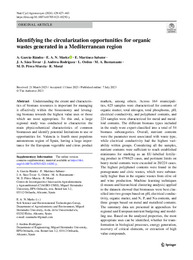Título :
Identifying the circularization opportunities for organic wastes generated in a Mediterranean region |
Autor :
Pérez Murcia, Mª Dolores 
García Rández, Ana
Netherton Marks, Evan Alexander
Orden, Luciano 
Martínez Sabater, Encarnación
Andreu Rodríguez, Fco. Javier 
Sáez Tovar, Jose Antonio 
Bustamante, Maria Angeles 
Moral, Raúl |
Editor :
Springer |
Departamento:
Departamentos de la UMH::Agroquímica y Medio Ambiente |
Fecha de publicación:
2023-03 |
URI :
https://hdl.handle.net/11000/34191 |
Resumen :
Understanding the extent and characteristics
of biomass resources is important for managing
it effectively within the bioeconomy and leveraging
biomass towards the highest value uses or those
which are most appropriate. To this end, a large
regional study was conducted to characterize the
main physicochemical characteristics of common
biomasses and identify potential limitations to use or
opportunities for. Valencia is fourth most populous
autonomous region of Spain, having a large importance
for the European vegetable and citrus product markets, among others. Across 164 municipalities,
625 samples were characterized for contents of
organic matter, total nitrogen, total phosphorus, pH,
electrical conductivity, and polyphenol contents, and
224 samples were characterized for metal and metalloid
contents. The different biomass types included
in the study were expert-classified into a total of 54
biomass subcategories. Overall, nutrient contents
were the parameter most associated with waste type,
while electrical conductivity had the highest variability
within groups. Considering all the samples,
nutrient contents were sufficient to reach established
minimums for marking as an EU-labelled fertilizing
product in 479/625 cases, and pertinent limits on
heavy metal contents were exceeded in 20/224 cases.
The highest polyphenol contents were found in the
pomegranate and citric wastes, which were substantially
higher than in the organic wastes from olive oil
and wine production. Machine learning techniques
(k-means and hierarchical clustering analysis) applied
to the datasets showed that biomasses were best classified
into two groups based on pH, electrical conductivity,
organic matter, and N, P, and Na contents, and
three groups based on metal and metalloid contents.
The summary data are presented in appendices for
regional and European nutrient budgeting and modelling
use. Based on the analyzed properties, the most
appropriate uses can be identified, whether for transformation
in biological processes, energy generation,
recovery of critical elements, or extraction of high
value compounds.
|
Palabras clave/Materias:
Circular bioeconomy
Nutrients
Polyphenols
Heavy metals
Olive mill waste
Machine learning |
Tipo de documento :
info:eu-repo/semantics/article |
Derechos de acceso:
info:eu-repo/semantics/openAccess
Attribution-NonCommercial-NoDerivatives 4.0 Internacional |
DOI :
https://doi.org/10.1007/s10705-023-10292-y |
Publicado en:
Nutrient Cycling in Agroecosystems Vol 129, pag 427–443, (2024) |
Aparece en las colecciones:
Artículos Agroquímica y Medio Ambiente
|
 La licencia se describe como: Atribución-NonComercial-NoDerivada 4.0 Internacional.
La licencia se describe como: Atribución-NonComercial-NoDerivada 4.0 Internacional.
.png)
